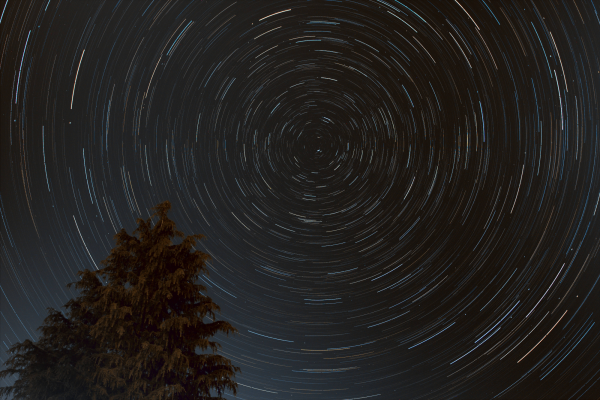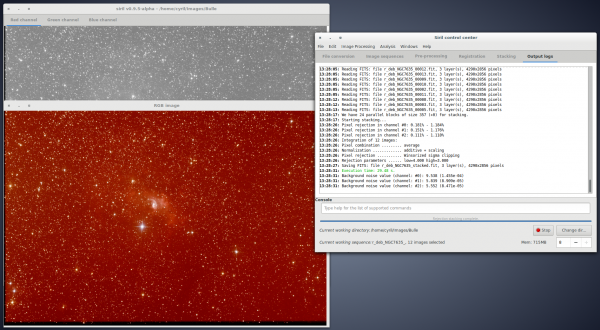Siril, a free astronomical image processing software
Siril is meant to be Iris for Linux (sirI-L). It is an astronomical image processing tool, able to convert, pre-process images, help aligning them automatically or manually, stack them and enhance final images. In 2017, is also began to work on Mac OS X and Windows.
Current version is 0.9.9 (stable). See the list of previous versions. A free online training for siril and a forum are up! Siril has a new website, siril.org, check it out! Siril is now on gitlab!
A new page explains how to use scripts and where to get them.

Who should use Siril?
Siril is targeted to amateur astronomers having acquired images and wanting to process them in a semi-automatic way. It provides a more user-friendly interface than Iris' command line as well as more modern and powerful processing algorithms, but it is not yet as automated as DeepSkyStacker or Registax. It also provides a basic command line to access various processing functions.
Siril is now fully capable to pre-process and process deep sky images. One feature still missing for planetary images processing is image deformation, but it is still capable of registering and processing them in an elegant way. The new star detection registration is perfect for deep sky images, but there are also two automatic translation-only registrations, one more suited for planetary and bright nebula images, based on Fourier transform, and another more simple targetted at deep-sky images, based on PSF on a single reference star. Additionally, a manual alignment capability makes it also well fitted for amateur astronomers having feature-less or bad quality images that automatic tools fail to align properly.
Professional astronomers generally use 32-bit depth images, but Siril uses only 16-bit images internally (except temporary for stacking). Loading 32-bit images is supported but it will degrade them since they will be converted to 16-bit (version 1.0 will use at least 32-bit depth channels internally). It can still be useful if the intent is to produce public-friendly pictures.
And more generally, people who want to use free software on free operating systems to process images. Siril can even be used to extract previewed frames from many videos formats. For an overview, see some image processing results.
News
For latest updates, see our bug and feature tracking system.
We are looking for volunteer translators, for the software and for the documentation. No programming experience is required. See the translation instructions page for software translation. In any case, check the status of your language translation with cyril (at free-astro.org) if you want to help.
The software is now considered stable. If you find a bug and want to report it (please, do!), feel free to report it on the bug report page.
- November 26, 2018
- Insight has landed! But the Siril news here is that we migrated our source code and bug management system to gitlab! Please use this modern way of communicating with us about code and problems now. The address of the project is https://gitlab.com/free-astro/siril/ . It's been a long year for us with many unfinished business for the 1.0 version. In the meantime, we are preparing a 0.9.10 stability release for very soon.
- June 7, 2018
- The new 0.9.9 version has been released, with bug fixes, and new script feature.
- February 19, 2018
- A patch of the 0.9.8 version has been released: 0.9.8.3.
- January 31, 2018
- The new 0.9.8 version has been released, with bug fixes, improvements on lucky imaging and Windows integration.
- December 4, 2017
- A new 0.9.8 version is progressing well and will particularly help people working on deep-sky lucky imaging.
- We have also started working on features for the next major version of Siril, version 1.0. The first development, started at the beginning of the year, aims to greatly speed up the display of images and the rendering effects and this looks very promising. Other major developments will be the use of a better precision, floating point, internal image format that will give better results with some algorithms, the parallelisation of preprocessing and the creation of a high quality registration and stacking method for planetary images. It will still take a lot of time, but that will be a fully featured and fast version of Siril. Current 0.9.x versions are stable and already provide great results for deep-sky image processing.
- September 21, 2017
- November 28, 2016
- October 8, 2016
- October 28, 2015
- First stable version available: 0.9.0. Stability updates and minor improvements will occur in the dedicated 0.9 branch.
- June 10, 2015
- New registration method available! It is now possible to register images with an automatic global star detection tool. The algorithm takes into account the translation and the rotation.
- April 13, 2015
- We have been working hard on accelerating stacking algorithms on multi-core CPUs, giving SER a better support and we are also working on the two main lacks of Siril: taking into account rotation and multi-point in registration, for better deep-sky and planetary registrations. These works are in progress, and will take some weeks to complete.
Many improvements have been done over the previous unmaintained version. The command line has been reactivated in large proportions, see the list of currently available commands on the dedicated Commands page. New commands and features have been and are being developed. For a complete list of features, see the 0.9.7 page, the roadmap, or the list of features below.
Ideas for the future of Siril are stored in the issues tracking system and can be seen by version in the milestones page. The list of known bugs is mixed with it and the full list is available here. The complete changelog is available either in the list of closed bugs or in the code source commits. A summary is available in the news section above and in the page of each release, as well as in the ChangeLog file. If you want to contribute, you are welcome!
Start using Siril / Documentation
Siril's works internally with FITS images, unsigned 16-bit per pixel and per channel. Some other FITS formats are supported. All other image formats you want to process with Siril have to be converted using the Conversion tab, but some sequence files are converted on-the-fly: SER and film sequences supported by ffmpeg (which means nearly all films).
For pre-processing, Siril applies master offset/bias, dark and flat images to the current sequence. These master images thus have to be processed before processing the actual image sequence. Siril currently does not support processing multiple sequences at the same time, so each layer of the final image must be processed independently before assembling them into an RGB image.
A free online course for siril has been set-up and new content is added regularly. Most uses of Siril will be described here with short films and exercices that allow you to learn by yourself and make sure you understood on concrete examples.
A Web-based documentation or PDF format for offline viewing, contain illustrated instructions on how to use particular features of Siril, along with a few videos to illustrate or describe these capabilities.
List of Siril features
New features are being introduced quite regularly. Here is a list of main features:
- Native image format support
- Unsigned 16-bit FITS files (other FITS are converted to this format on-the-fly)
- SER files
- AVI and many other film files, their support is being dropped in favour of SER.
- Image conversion (to the native FITS format only)
- Supported input types: 8-bit and 16-bit BMP, TIFF, JPEG, PNG files, NetPBM binary images, RAW DSLR images.
- Pre-processing of images with multi-channel offset, dark and flat images
- Image registration; supported methods:
- Global star alignment (rotation + translation)
- Translation using DFT centred on an object, generally used for planetary images
- Translation using PSF of a star, generally used for deep-sky images
- Manual translation with two preview renderings of the current image with reference frame in transparency
- Registered sequence export
- Supported export file formats: Siril FITS sequence, SER sequence, uncompressed AVI files, GIF up to 0.9.4, MP4 and WEBM web publishing video formats since 0.9.5
- Optional cropping and resizing of the exported images
- Image stacking, with optional additive or multiplicative normalization
- Summing
- Median
- Average with rejection (percentile, sigma, median, Winsorized and linear fit clipping)
- Pixel minimum or maximum across images
- Enhancement and processing of final images
- Lightness/contrast cursors on each layer, different scaling modes (linear, log, square root, squared, asinh, histogram equalisation), negative and false colour rendering and clipping
- Background removal tool
- Cosmetic correction tool
- A command line for various processing functions, only available from the GUI, see the list of available commands.
- A star finding algorithm with PSF information
- Image compositing tool, combining and aligning multiple layers (2 to 6) with custom colours into a resulting image, with luminance layer support
- Plotting various pieces of information about an image sequence (FWHM, star roundness, periodic error of the mount, amplitude, background level...)
Compilation and installation
See Siril installation page. It documents which binary packages you can get and how to build from source if needed, for multiple operating systems. Siril is a free software, licence is GPL3.
To install standalone binaries, please go to this page, choose the last version and download the binary corresponding to your OS.
Who is behind Siril?
Vincent is a computer scientist (PhD) and uses Siril as an amateur to process images from a Canon EOS, a QSI and a Basler camera on a 410mm telescope.
Cyril is a physicist (PhD), now IT engineer at CNRS, motivating new developments and providing high quality processing algorithms to Siril.
Laurent is a senior IT project manager and also uses Siril to process images from a Canon EOS and a ZWO camera on a 254mm telescope. He manages the formatting of the documentation, using Scenari technology and the Moodle online training.
François Meyer wrote the initial (up to v0.8) versions. Here are the legacy Sourceforge project and website.
See the AUTHORS file for the complete list of contributors.
If you like the software, please help us by contributing with the Donate button on the top right. Siril takes us a lot of time and we still have to pay for the servers.
